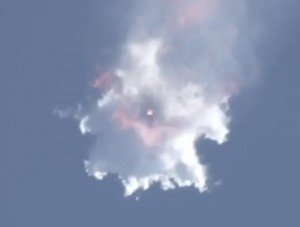 Students in Minnehaha Academy’s Applied Research in Engineering program were especially disappointed to watch the SpaceX’s unmanned rocket explode just after takeoff from the Kennedy Space Center in Florida in late June. On board was their biology experiment destined for the International Space Station (ISS).
Students in Minnehaha Academy’s Applied Research in Engineering program were especially disappointed to watch the SpaceX’s unmanned rocket explode just after takeoff from the Kennedy Space Center in Florida in late June. On board was their biology experiment destined for the International Space Station (ISS).
Photo: Photo by NASA/SpaceX, from the video of the explosion
The students had worked for eight months designing, testing, building, and sterilizing the experiment to measure the effects of microgravity on bacteria growth and using artificial shark skin to inhibit that growth. This experiment is important because bacteria have been shown to be more virulent in space travel. The students hoped the results of their experiment would help protect astronauts from infectious diseases and improve space flight conditions.
Student team members Hazen Mayo and Andrew Johnson were at Cape Canaveral to witness the launch. “It was an incredible disappointment seeing a years’ worth of collaboration and research and time and energy come to an abrupt and untimely end,” Mayo told KARE 11. “As soon as I saw it, I knew something had gone terribly wrong.” Despite the turn of events, Mayo and her fellow teammates have remained positive.
“This is a great teachable moment for our students,” said Minnehaha Academy’s ISS science teacher Sam Terfa. “Space exploration is tough work, dangerous and disappointing at times. Science and engineering require people to prepare for the worst case scenario and be as thorough as possible.“
While the rocket explosion is certainly disappointing to the ISS team and the whole school community, they concur with the statement from NASA: “this is a reminder that spaceflight is an incredible challenge, but we learn from each success and each setback. This launch attempt will not deter us from our ambitious human spaceflight program.”
And it will not deter Minnehaha Academy students; they are planning to design two experiments to launch to the ISS in the 2015-2016 school year.
“Studying the effects of microgravity is frontier science,” Terfa said. “Our students have the ability to discover new things that were never known before in science. So many times science classes only cover what has already been discovered. It’s rare that students can learn something brand new about the universe. While it’s tough developing these experiments, and at times the results never come how they thought they would, it’s completely worth it to learn new skills.”
Minnehaha Academy is the only school in the Midwest to offer this program, and seven professional engineers, geneticists, and computer programmers, as well as two Minnehaha Academy science teachers, mentored the ISS students. Students were invited to conduct parts of their research in the laboratories of their mentors at the University of Minnesota.
A state-of-the-art STEM facility is under construction at Minnehaha Academy for the 2015-2016 school year. This new facility will help students be positioned to excel in the science fields. Classes such as physics, chemistry, and the International Space Station project will take advantage of all this new space will offer. New courses are also under development.
Comments
No comments on this item Please log in to comment by clicking here